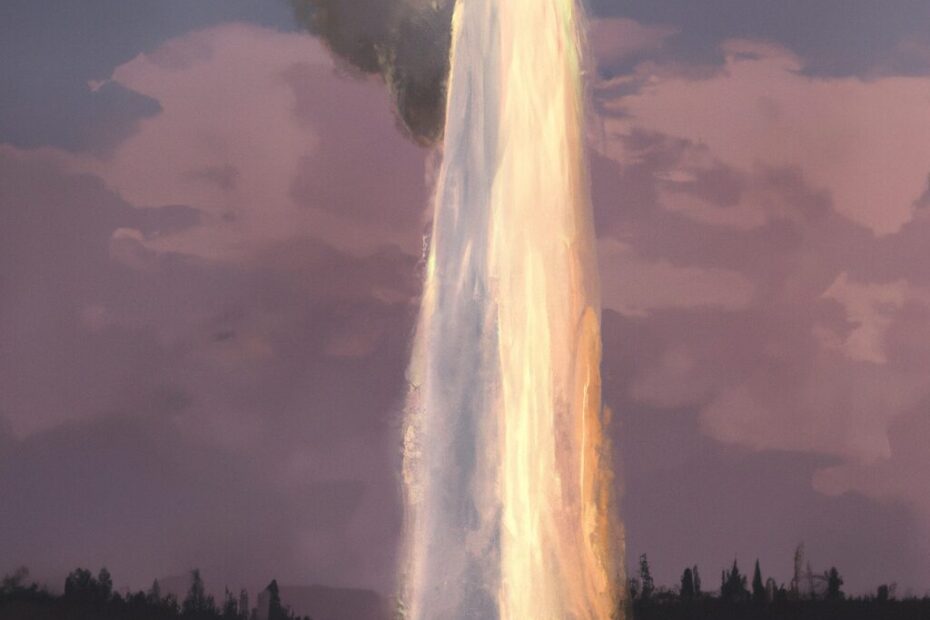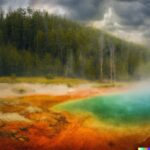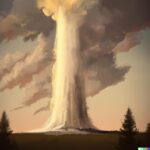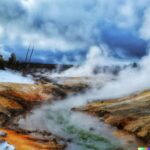Have you ever wondered what makes Yellowstone’s geothermal areas so unique? From the rare geysers found in these natural wonders to the factors that affect their eruption, there’s so much to explore.
In this article, we’ll take a closer look at the role of heat, water, and pressure in geothermal areas, as well as the precautions to consider when visiting Yellowstone. And of course, we’ll delve into the rare geysers, including the incredible Steamboat Geyser and the impressive Giantess Geyser. So, let’s dive in and uncover the fascinating world of Yellowstone’s geothermal wonders!
What Are Geysers?
Geysers are rare and unique thermal features commonly found in geothermal areas such as Yellowstone. They are characterized by intermittent eruptions of hot water and steam caused by volcanic activity and geologic processes.
Geothermal features are formed when groundwater seeps deep into the Earth’s crust. There, it is heated by the molten rock beneath the surface. As the water becomes superheated, it builds up pressure until it eventually erupts through a vent, creating the spectacular display of a geyser.
The significance of geysers lies in their role as indicators of geothermal activity and the incredible geological forces at work beneath the Earth’s surface. This makes them essential to the understanding of the natural world and its processes.
Where Are Yellowstone Geothermal Areas?
Yellowstone National Park is renowned for its vast geothermal areas, encompassing a myriad of geysers, thermal pools, and unique geothermal features that captivate visitors with their natural wonders.
What Makes Yellowstone Geothermal Areas Unique?
Yellowstone’s geothermal areas are truly exceptional due to the park’s geothermal environment, which harbors unique geological formations, abundant geothermal resources, and captivating attractions that showcase the power of geothermal energy.
What Is the Role of Heat in Geothermal Areas?
Heat serves as the fundamental driver of geothermal areas, originating from the Earth’s core and manifesting within the geothermal field as thermal phenomena that give rise to various geothermal features.
This natural heat results from the slow radioactive decay of elements like uranium, thorium, and potassium within the Earth’s mantle and crust. As this heat moves towards the surface, it creates temperature differentials that fuel geothermal systems.
These thermal phenomena include hot springs, geysers, and fumaroles, each shaped by the specific underground conditions and the movement of fluids through the subsurface. The role of heat in sustaining these geothermal features highlights its indispensable influence on the unique characteristics and functionality of geothermal areas.
What Is the Role of Water in Geothermal Areas?
Water plays a crucial role in geothermal areas, interacting with the geothermal heat to form hydrothermal systems that give rise to awe-inspiring hot springs and other thermal features.
This interplay results in the creation of mesmerizing phenomena such as geysers, fumaroles, and mud pots. As the water percolates deep into the Earth’s crust, it comes into contact with the heat generated from the mantle, leading to the formation of these remarkable features.
The unique chemistry of the water, enriched with minerals and gases, contributes to the vibrant colors and distinct odors found in these geothermal areas, making them not only visually stunning but also scientifically fascinating.
What Is the Role of Pressure in Geothermal Areas?
Pressure exerts a significant influence in geothermal areas, driving geyser activity and contributing to the formation of unique geologic formations shaped by the geological forces at play.
This pressure arises from the intense heat and underground molten rocks, which lead to the buildup of steam and water within the Earth’s crust. The accumulation of this pressurized mixture ultimately propels the spectacular eruptions seen in geysers.
The constant pressure and heat contribute to the gradual formation of distinct geological features such as hot springs, mud pots, and terraces, showcasing the powerful and transformative impact of pressure in shaping geothermal phenomena.
What Are the Rare Geysers Found in Yellowstone?
Yellowstone is home to a selection of rare geysers that captivate visitors with their unique and infrequent eruptions, adding to the allure of the park’s geothermal landscape.
Steamboat Geyser
Steamboat Geyser stands out as one of Yellowstone’s rare geysers, renowned for its spectacular and powerful eruptions that mesmerize visitors, contributing to the park’s diverse array of geysers and hot springs.
Located in Yellowstone National Park, Steamboat Geyser is a sight to behold. Standing at 300 feet tall, it is the tallest active geyser in the world. But what makes it truly unique is its unpredictable eruptions, which can occur anywhere from a few days to several years apart.
This natural wonder is a testament to the raw power and beauty of Yellowstone’s geothermal features. Its infrequent displays leave a lasting impression on all those lucky enough to witness them, making it a must-see attraction in the park.
Giantess Geyser
Giantess Geyser, a rare thermal feature in Yellowstone, commands attention with its intermittent eruptions and adds to the park’s fascinating array of geysers and thermal pools.
Located in the Upper Geyser Basin, the Old Faithful geyser is known for its impressive height of up to 200 feet during eruptions. Its infrequent displays make it a highly anticipated event, drawing in visitors who are eager to witness its awe-inspiring power.
As one of Yellowstone’s hydrothermal wonders, the eruptions of Old Faithful add to the overall spectacle of the park and enrich the experience for all who explore this unique natural phenomenon.
Sawmill Geyser
Sawmill Geyser, an infrequent thermal attraction within the geothermal field of Yellowstone, showcases unique geological formations and contributes to the park’s geothermal diversity.
Located in Yellowstone National Park, the Old Faithful geyser is a natural wonder that never fails to impress. Its intermittent eruptions, sometimes reaching heights of up to 30 feet, captivate visitors with the power and unpredictability of geothermal activity. The geyser’s intricate mineral deposits, formed over centuries, create a colorful and otherworldly landscape that adds to its mystique. Its remote location in the tranquil wilderness of Yellowstone National Park also draws hikers and nature enthusiasts seeking to witness its rare displays.
Beehive Geyser
Beehive Geyser, known for its rare and impressive eruptions, stands as a captivating thermal wonder in Yellowstone, adding to the park’s collection of rare geysers.
Beehive Geyser is a popular attraction in Yellowstone National Park, known for its towering plumes of boiling water and steam that can reach up to 200 feet in the air. These eruptions are infrequent, making each display a truly special event for lucky visitors.
The geyser’s location within the Upper Geyser Basin adds to its allure, as it is surrounded by other unique geothermal features. This creates an unforgettable experience for nature enthusiasts and curious travelers alike.
Fan and Mortar Geysers
The Fan and Mortar Geysers offer a distinct and visually captivating showcase of geothermal activity, contributing to the park’s wealth of geothermal attractions and resources.
The unique formations of Yellowstone’s Fan Geyser and Mortar Geyser are a sight to behold. The Fan Geyser erupts water in a fan-like pattern while the Mortar Geyser shoots water and steam high into the air. These geysers not only add to the vibrant geothermal landscape but also play a vital role in maintaining the balance of the ecosystem. They provide valuable insights into geothermal processes and contribute to the understanding of geological phenomena.
Visitors are captivated by the mesmerizing displays of these geysers, making them iconic symbols of Yellowstone’s unparalleled geothermal wonders.
How Do These Rare Geysers Erupt?
The rare geysers in Yellowstone erupt through a combination of intricate geyser activity, geologic processes, and thermal phenomena, culminating in captivating and infrequent eruptions that define their unique allure.
What Factors Affect the Eruption of Geysers?
The eruption of geysers is influenced by various factors, including the interplay of geothermal energy, internal processes, and external stimuli that contribute to the mesmerizing geyser eruptions observed in Yellowstone and other geothermal areas.
Geothermal energy, originating from the Earth’s heat, plays a crucial role in heating the water underground, ultimately leading to the explosive release of steam and water.
Internal processes within the geyser’s plumbing system, such as the constriction and expansion of channels, also contribute to the build-up of pressure, which is released in a spectacular eruption.
External stimuli like seismic activity or precipitation can further impact geyser eruptions by altering the delicate balance of underground hydrothermal systems.
What Precautions Should Be Taken When Visiting Yellowstone Geothermal Areas?
When visiting Yellowstone’s geothermal areas, it is essential to exercise caution around geysers and other geothermal features due to the dynamic and potentially hazardous nature of the geothermal environment. This ensures a safe and enjoyable experience for all visitors.
To stay safe, it is crucial to follow designated boardwalks and marked trails. This helps prevent accidental burns and injuries from the scalding hot water and steam vents. It is also important to never touch or throw objects into the geothermal features, as this can cause severe burns and disrupt the delicate ecosystem balance.
Visitors should also be aware of the strong sulfuric odor and potential release of toxic gases. It is recommended to retreat to a safe distance if necessary. By following these safety precautions, visitors can enjoy the geothermal wonders while minimizing risks to themselves and the environment.
Frequently Asked Questions
What are rare geysers in Yellowstone geothermal areas?
Rare geysers in Yellowstone geothermal areas are geysers that have infrequent eruptions and are not as well-known or popular as other geysers in the region.
How are rare geysers formed in Yellowstone geothermal areas?
Rare geysers are formed when a combination of underground water and heat cause pressure to build up and create a vent for the water to erupt from. These conditions are not as easily met in certain areas, resulting in rare geysers.
Why are rare geysers important in Yellowstone geothermal areas?
Rare geysers play a crucial role in the ecosystem of Yellowstone’s geothermal areas. They provide unique habitats for microorganisms and support a diverse range of plant and animal life.
Can visitors see rare geysers in Yellowstone geothermal areas?
Yes, visitors can see rare geysers in Yellowstone geothermal areas, but they may require some hiking or off-trail exploration to find. It is important to always follow park regulations and safety guidelines when seeking out rare geysers.
Are there any precautions to take when viewing rare geysers in Yellowstone geothermal areas?
Yes, it is important to never touch or throw objects into rare geysers. The water and steam can be extremely hot and cause serious burns. It is also important to stay on designated trails and follow park regulations to protect the delicate ecosystem surrounding these rare geysers.
Are rare geysers in Yellowstone geothermal areas in danger of disappearing?
Yes, rare geysers, like all natural features, are at risk due to human impact and climate change. It is important to respect these natural wonders and do our part to protect them for future generations to enjoy.
Last Updated on February 7, 2024 by Jon Waraas – Originally Posted: January 25, 2024

I’m Jon Waraas, and I’ve been navigating the online world since 2006. By day, I’m the proud owner of some eCommerce gems, and by night, I’m the voice behind the adventures on Waraas.Com.
My heart, however, belongs to the wild beauty of Yellowstone National Park. I’ve got a collection of websites dedicated to sharing the wonders of this natural masterpiece. Oh, and did I mention? I’m currently building my own cabin inside the ghost town of Gilmore, Idaho – a cabin with tales to tell!
When I’m not immersed in the digital realm, you’ll find me lacing up my boots for a good hike or setting up camp under the star-studded sky.




